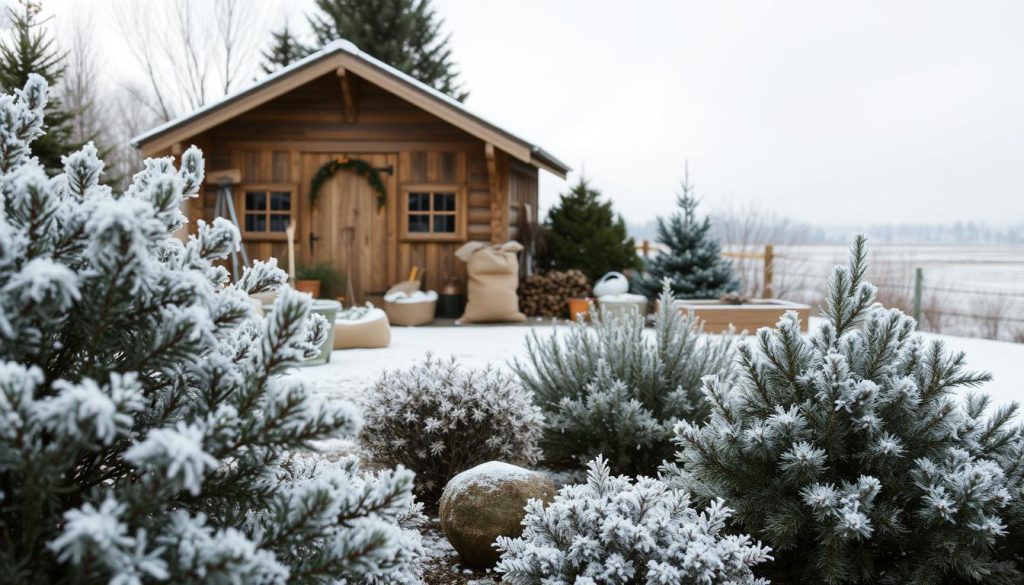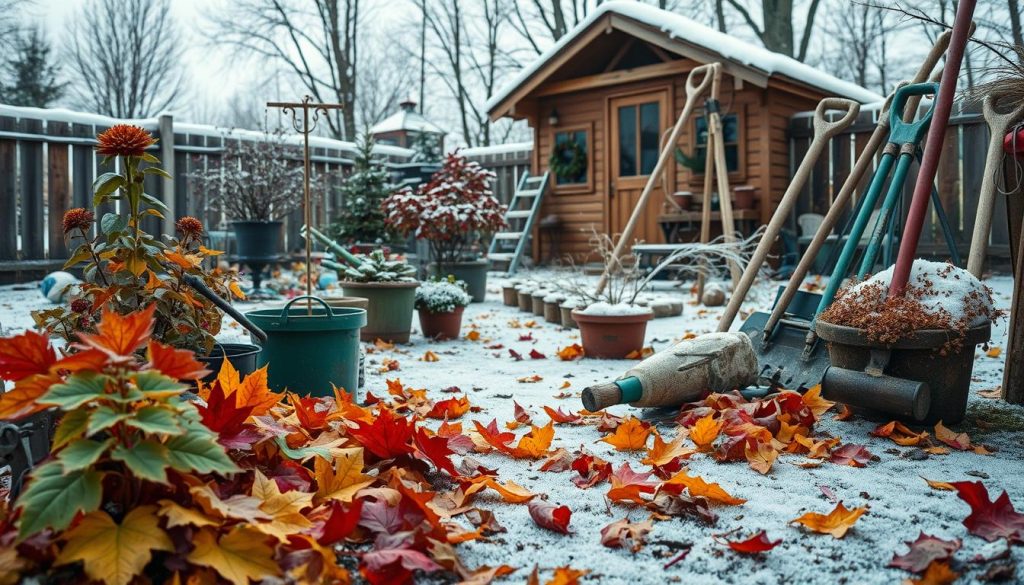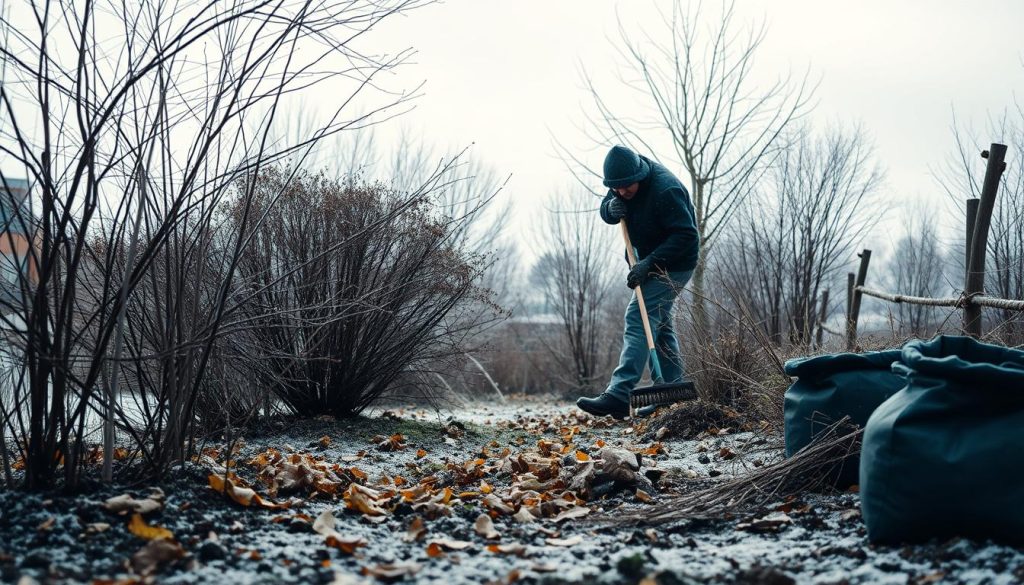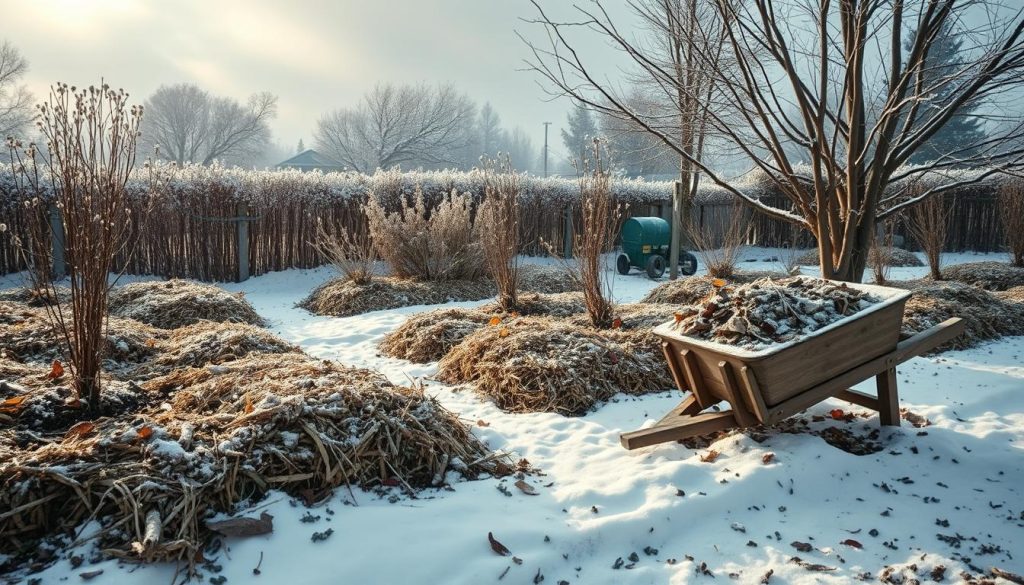As winter gets closer, preparing my garden is a top priority. It’s key to keep my plants healthy during the cold months. I’ll share my top tips to help you prepare your garden for winter.
To keep your garden in great shape, you need the right winter prep. This article will guide you through the best gardening tips for winter. We’ll cover everything from cleaning up to protecting plants from frost.
Understanding the Importance of Winter Garden Preparation
As winter gets closer, it’s key to get your garden ready for the cold. Winter garden care tips help keep your plants safe and healthy. A well-prepared garden can avoid damage from frost, snow, and ice. It also makes sure your plants are ready to grow when spring comes.
Following good winter garden care advice protects your plants from extreme cold and moisture loss. This means removing dead plants, cutting back perennials, and using mulch to keep moisture in and weeds out. Also, check your garden for any damaged or diseased plants and stop disease from spreading.
Why Winter Prep Matters
Winter prep is more than just cleaning up your garden. It’s about setting up your garden for a healthy spring. By preparing your garden for winter, you protect your plants and get them ready to grow when it warms up. This includes pruning, fertilizing, and pest control, all key for a healthy garden.

Benefits of a Well-Prepped Garden
A well-prepped garden has many benefits, like better plant health, more yields, and less upkeep. By following winter garden maintenance tips, you can have a garden that thrives, even in harsh winter weather. Some benefits include:
- Improved soil health
- Increased plant resistance to disease and pests
- Reduced risk of damage from extreme weather conditions
- Improved overall garden appearance
By focusing on winter garden preparation, you can ensure your garden’s success. This way, you can enjoy a thriving and healthy garden all year.
Assessing Your Current Garden Condition
As winter gets closer, it’s key to get your garden ready. You need to check how your plants are doing. This helps you know what to do to keep them safe.
Start by walking through your garden. Look at your plants closely. See if they have any diseases or pests. Note any plants that look weak. This helps you know where to focus your efforts.
Evaluating Plant Health
Checking your plants’ health is very important. Look at their leaves, stems, and roots for damage or disease. Watch for any color changes, wilting, or odd growth. This helps you fix problems before it gets too cold.
Identifying Vulnerable Plants
It’s also important to find out which plants can’t handle the cold. Some plants are more sensitive than others. You might need to cover them, bring potted plants inside, or use row covers to protect them.

By checking your garden and finding weak spots, you can protect your plants. This way, your garden will be healthy and strong when spring comes. Remember, getting your garden ready for winter is crucial for a great gardening season.
Cleaning Up Debris for Winter
As winter approaches, I focus on cleaning up my garden. This is key to keep diseases and pests away. By removing leaves, weeds, and debris, I protect my garden and prepare it for the next growing season.
I start by taking out dead or dying plants, including leaves and weeds. This stops diseases and pests from spreading. I also clean my tools to prevent disease spread. This keeps my garden safe and my tools ready for spring.
Removing Leaves and Weeds
- Remove dead or dying plants, including leaves and weeds, from garden beds
- Dispose of debris in a compost bin or by bagging it for trash collection
- Use a rake or leaf blower to remove leaves and debris from lawns and garden beds
Cleaning Tools and Equipment
Cleaning my tools is crucial for winter garden care. I wash them with soap and water, then dry them to prevent rust. Sharpening my pruning tools also helps. These steps ensure my garden stays healthy through winter and into spring.

Mulching: A Layer of Protection
As winter approaches, I make sure to protect my garden. Mulching is key to keeping plants safe from frost and cold. It helps retain moisture, suppress weeds, and control soil temperature. This makes it a vital part of my winter gardening tips.
Choosing the right mulch is important. I consider my plants, climate, and the look I want. Organic mulches like wood chips, bark, and straw are popular. They’re effective and good for the environment. I also think about how much mulch I need, based on my garden’s size and plant needs.
Choosing the Right Mulch
- Organic mulches like wood chips, bark, and straw
- Inorganic mulches like plastic sheeting and landscape fabric
- Consider the type of plants, climate, and desired aesthetic
How Much Mulch Do You Need?
The amount of mulch needed varies by garden size and plant needs. A 2-3 inch layer is usually enough. I also add more mulch as needed to keep it effective.

Protecting Plants from Frost
As winter gets closer, it’s key to protect your plants from frost. Frost can harm plants, especially the sensitive ones, and might even kill them. To keep your plants safe, you can cover them. This helps keep the heat in and protects them from frost.
For winter garden care, using row covers or cloches is a great idea. These covers shield your plants from frost and harsh weather. By doing these things, your plants will stay healthy and grow well in winter. Here are more ways to protect your plants:
- Covering plants with a layer of straw or burlap to retain heat
- Using cold frames or greenhouses to provide extra protection
- Bringing potted plants indoors to a warm and safe location
By taking these steps, you can keep your plants safe from frost. This way, your garden will stay healthy and look great all winter. Always follow good winter garden care advice and prepare your garden for winter.
With a bit of planning and getting ready, you can have a beautiful garden all year. So, start now to protect your plants from frost. Get ready for a great winter garden.
| Method | Benefits |
|---|---|
| Covering plants with a layer of straw or burlap | Retains heat, protects from frost |
| Using row covers or cloches | Protects from frost, harsh weather conditions |
| Bringing potted plants indoors | Provides a warm and safe location |
Watering Before the Freeze
As winter comes, it’s key to keep your garden healthy. Watering your plants before the freeze is a must. This helps keep the soil moist, protecting your plants from cold damage.
Watering before the freeze lets plants get the moisture they need for winter. This is a smart move to keep your garden strong when spring comes. Water your plants deeply a few days before the freeze, making sure the soil is moist but not too wet.
Importance of Moisture Retention
Keeping the soil moist is crucial for winter. Dry soil can make roots brittle and vulnerable to cold damage. Moist soil acts as a shield, protecting your plants from winter’s harshness.
Best Practices for Winter Watering
Water your plants in the morning to let the soil soak up the water all day. Avoid wetting the leaves or stems to prevent ice damage. Instead, water the soil around the base of the plants to keep them moist through winter.
By following these tips, you’ll make your garden strong and ready for winter. Your garden will be ready to flourish when spring arrives.
| Winter Watering Tips | Benefits |
|---|---|
| Water plants deeply before freeze | Retains moisture, reduces damage from freezing temperatures |
| Water in the morning | Allows soil to absorb moisture throughout the day |
| Avoid getting water on leaves or stems | Prevents ice from forming, reduces damage to plants |
Preparing Your Soil for Winter
As winter gets closer, it’s key to keep your soil healthy and fertile. Testing your soil’s health is a must. This checks the pH level and nutrient content to see if changes are needed.
Testing your soil is a vital step. You can buy a kit or send a sample to a lab. After getting the results, add compost or manure to boost the soil’s health.
- Apply mulch to keep moisture in and weeds out
- Use organic matter to enhance soil structure and fertility
- Avoid over-tilling to protect soil and microorganisms
By following these tips, your soil will do well in winter. This sets you up for a great growing season in spring.
Planning for Next Season
As I get my garden ready for winter, I think about what will make next season great. Crop rotation is key to keep the soil healthy and prevent pests. It makes my garden strong and balanced.
Choosing the right winter vegetables is important. I love growing broccoli, kale, and spinach because they do well in cold weather. I pick vegetables based on my garden’s climate, soil, and sunlight.
Crop Rotation Considerations
- Rotate crops to avoid depleting soil nutrients
- Choose crops that complement each other in terms of growth habits and space requirements
- Consider the mature size of each crop and leave enough space for proper growth
Selecting Winter Vegetables
Some popular winter vegetables include:
- Broccoli
- Kale
- Spinach
- Carrots
- Brussels sprouts
By following these tips and thinking about crop rotation and vegetable selection, I can make my garden thrive next season.
Maintaining Garden Structures
When we talk about winter garden care, we must think about garden structures. These include fences, edging, trellises, and arbors. They help keep your garden’s layout and protect plants from bad weather.
To keep your garden safe and working well in winter, you need to take care of these structures. Check for damage and fix it if you find any. This way, you protect your garden and help your plants grow strong.
Checking Fences and Edging
First, look at your fences and edging for any damage. Check if boards are loose or broken. Make sure the edging is still in place. Fix any problems to keep your garden safe and your plants happy.
Repairing Trellises or Arbors
Trellises and arbors can get damaged by winter weather. So, it’s important to check them often. Look for broken or damaged parts and fix them. You can also use a protective coating to keep the wood safe.
By following these tips, you can keep your garden healthy and beautiful all year. Stay on top of maintenance and ask for help if you need it. This way, your garden will always look its best.
| Garden Structure | Maintenance Task | Frequency |
|---|---|---|
| Fences | Inspect for damage | Monthly |
| Edging | Check for loose or broken pieces | Bi-monthly |
| Trellises/Arbors | Inspect for broken limbs | Quarterly |
Creating a Winter Wildlife Habitat
As I prepare my garden for winter, I aim to make it a welcoming spot for local wildlife. This effort not only beautifies my garden but also helps the local ecosystem. By following winter garden maintenance tips, I can offer food and shelter to animals, helping them survive the cold.
To support wildlife, I focus on planting native species that offer berries, seeds, or nectar. These plants are crucial for birds, bees, and other creatures that need a steady food supply. I also create a sheltered spot using native plants, like shrubs or trees, to protect them from wind and predators.
Supporting Local Wildlife
To help local wildlife, I take a few easy steps. These include:
- Planting native species that provide food and shelter
- Creating a source of water, such as a birdbath or pond
- Providing a sheltered area using native plants or a brush pile
Using Native Plants for Shelter
Native plants are key to creating a winter habitat for wildlife. They offer shelter, food, and a safe place for animals to breed and raise their young. Some native plants that work well for shelter include:
| Plant Species | Benefits |
|---|---|
| Shrubs | Provide shelter and food for birds and small mammals |
| Trees | Offer protection from harsh winds and predators |
| Grasses | Provide habitat for insects and small animals |
Reflecting on Your Gardening Year
Winter is here, and it’s a great time to look back on your gardening year. Think about what went well and what didn’t. Did your heirloom tomatoes do great, or did pests ruin your greens? Writing down these thoughts will help you improve your winter garden care advice and use the best winter gardening tips for next year.
Lessons Learned
Look through your garden journal or remember what worked and what didn’t. Maybe your new raised beds really boosted your veggie yields. Or perhaps your soil needed more organic matter for your flowers. These lessons will help you make better choices next year.
Setting Goals for the Future
Now, think about what you want to achieve in your garden next year. Do you want to try new heirloom varieties? Grow more herbs? Or attract more pollinators? Writing down your goals will keep you on track and excited for the winter gardening season.

